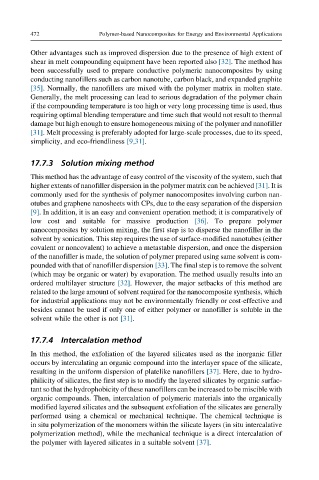Page 519 - Polymer-based Nanocomposites for Energy and Environmental Applications
P. 519
472 Polymer-based Nanocomposites for Energy and Environmental Applications
Other advantages such as improved dispersion due to the presence of high extent of
shear in melt compounding equipment have been reported also [32]. The method has
been successfully used to prepare conductive polymeric nanocomposites by using
conducting nanofillers such as carbon nanotube, carbon black, and expanded graphite
[35]. Normally, the nanofillers are mixed with the polymer matrix in molten state.
Generally, the melt processing can lead to serious degradation of the polymer chain
if the compounding temperature is too high or very long processing time is used, thus
requiring optimal blending temperature and time such that would not result to thermal
damage but high enough to ensure homogeneous mixing of the polymer and nanofiller
[31]. Melt processing is preferably adopted for large-scale processes, due to its speed,
simplicity, and eco-friendliness [9,31].
17.7.3 Solution mixing method
This method has the advantage of easy control of the viscosity of the system, such that
higher extents of nanofiller dispersion in the polymer matrix can be achieved [31].It is
commonly used for the synthesis of polymer nanocomposites involving carbon nan-
otubes and graphene nanosheets with CPs, due to the easy separation of the dispersion
[9]. In addition, it is an easy and convenient operation method; it is comparatively of
low cost and suitable for massive production [36]. To prepare polymer
nanocomposites by solution mixing, the first step is to disperse the nanofiller in the
solvent by sonication. This step requires the use of surface-modified nanotubes (either
covalent or noncovalent) to achieve a metastable dispersion, and once the dispersion
of the nanofiller is made, the solution of polymer prepared using same solvent is com-
pounded with that of nanofiller dispersion [33]. The final step is to remove the solvent
(which may be organic or water) by evaporation. The method usually results into an
ordered multilayer structure [32]. However, the major setbacks of this method are
related to the large amount of solvent required for the nanocomposite synthesis, which
for industrial applications may not be environmentally friendly or cost-effective and
besides cannot be used if only one of either polymer or nanofiller is soluble in the
solvent while the other is not [31].
17.7.4 Intercalation method
In this method, the exfoliation of the layered silicates used as the inorganic filler
occurs by intercalating an organic compound into the interlayer space of the silicate,
resulting in the uniform dispersion of platelike nanofillers [37]. Here, due to hydro-
philicity of silicates, the first step is to modify the layered silicates by organic surfac-
tant so that the hydrophobicity of these nanofillers can be increased to be miscible with
organic compounds. Then, intercalation of polymeric materials into the organically
modified layered silicates and the subsequent exfoliation of the silicates are generally
performed using a chemical or mechanical technique. The chemical technique is
in situ polymerization of the monomers within the silicate layers (in situ intercalative
polymerization method), while the mechanical technique is a direct intercalation of
the polymer with layered silicates in a suitable solvent [37].

